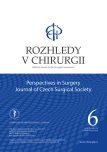Endoscopic pilonidal sinus treatment (E.P.Si.T.) – first experiences and results
Authors:
M. Probst 1; V. Mezera 2; P. Turnovský 1; M. Hácová 3; L. Sákra 1
Authors‘ workplace:
Chirurgická klinika, Nemocnice Pardubického kraje, a. s., Pardubická nemocnice
1; Geriatrické centrum, Nemocnice Pardubického kraje, a. s., Pardubická nemocnice
2; Patologicko-anatomické odd., Nemocnice Pardubického kraje, a. s., Pardubická nemocnice
3
Published in:
Rozhl. Chir., 2020, roč. 99, č. 6, s. 266-270.
Category:
Original articles
doi:
https://doi.org/10.33699/PIS.2020.99.6.266–270
Overview
Introduction: The aim of our article is to present the results and experience with the method E.P.Si.T. – endoscopic pilonidal sinus treatment.
Methods: The operation is performed using a special endoscope – fistuloscope. In the first phase, we determine the extent and look for all the sinus tracts. In the second phase, the whole complex is treated with a grasper, a brush and an electrode from the inside.
Results: A total of 21 operations were performed at our department from December 2018 through September 2019. In our sample, men predominated 6:1. Mean age of the patients was 27 years. Complete healing was achieved in 18 patients. Two patients were not healed primarily. One patient was lost to follow-up.
Conclusion: According to the first experience and results, the E.P.Si.T. seems to be a very good method for treating pilonidal sinus. Compared to open procedures, the length of hospitalization, the need for analgesics and antibiotics were significantly reduced. The period of convalescence was shortened and the return to normal life was faster. The size of the cohort and the duration of post-operative follow-up do not allow us yet to statistically evaluate the results.
Keywords:
endoscopy – pilonidal sinus – E.P.Si.T. – minimally invasive surgical procedures – fistuloscope
Sources
- Emile SH, Elfeki H, Shalaby M, et al. Endoscopic pilonidal sinus treatment: a systematic review and meta-analysis. Surg Endosc. 2018;32(9):3754−3762. doi:10.1007/s00464-018-6157-5.
- Mayo OH. Observations on injuries and diseases of the rectum. London, Burgess and Hill 1833.
- Burhan HK, Selim S. Disease that should be remembered: Sacrococcygeal pilonidal sinus disease and short history. World J Clin Cases 2015;3(10):876−879. doi:10.12998/wjcc.v3.i10.876.
- Örhalmi J, Sotona O, Dušek T, et al. Pilonidální sinus – možnosti operačního řešení. Rozhl Chir. 2014;93(10):491−495.
- Luedi MM, Kauf P, Evers T, et al. Impact of spinal versus general anesthesia on postoperative pain and longterm recurrence after surgery for pilonidal disease. J Clin Anesth. 2016;33:236−242. doi:10.1016/j.jclinane.2016.03.061.
- Esposito C, Izzo S, Turrà F, et al. Pediatric endoscopic pilonidal sinus treatment, a revolutionary technique to adopt in children with pilonidal sinus fistulas: Our preliminary experience. J Laparoendosc Adv Surg Tech A. 2018;28(3):359−363. doi:10.1089/lap.2017.0246.
- Bascom J. Pilonidal disease: origin from follicles of hairs and results of follicle removal as treatment. Surgery 1980;87(5):567–572.
- Karydakis GE. Easy and successful treatment of pilonidal sinus after explanation of its causative process. Aust N Z J Surg. 1992;62(5):385–389.
- Varnalidis I, Ioannidis O, Paraskevas G, et al. Pilonidal sinus: a comparative study of treatment methods. J Med Life 2014;7(1):27–30.
- Hardy EJO, Herrod PJ, Doleman B, et al. Surgical interventions for the treatment of sacrococcygeal pilonidal sinus disease in children: A systematic review and meta-analysis. J Pediatr Surg. 2019;54(11):2222−2233. doi:10.1016/j.jpedsurg.2019.02.058.
- Erkent M, Şahiner IT, Bala M, et al.Comparison of primary midline closure, Limberg flap, and Karydakis flap techniques in pilonidal sinus surgery. Med Sci Monit. 2018;24:8959−8963. doi:10.12659/MSM.913248.
- Bendewald FP, Cima RR. Pilonidal disease. Clin Colon Rectal Surg. 2007;20(2):86−95. doi:10.1055/s-2007-977486.
- Meinero P, Mori L, Gasloli G. Endoscopic pilonidal sinus treatment (E.P.Si.T.). Tech Coloproctol. 2014;18(4):389−392. doi:10.1007/s10151-013-1016-9.
- Meinero P, Mori L. Video-assisted anal fistula treatment (VAAFT): a novel sphincter-saving procedure for treating complex anal fistulas. Tech Coloproctol. 2011;15(4):417−422. doi:10.1007/s10151-011-0769-2.
Labels
Surgery Orthopaedics Trauma surgeryArticle was published in
Perspectives in Surgery

2020 Issue 6
Most read in this issue
- Laparoscopic inguinal hernia repair in children via PIRS (percutaneous internal ring suturing)
- Zenker’s diverticulum – effectiveness of endoscopic therapy
- Endoscopic pilonidal sinus treatment (E.P.Si.T.) – first experiences and results
- Update and review of diagnosing functional anorectal disorders – standardized protocol for high-resolution anorectal manometry and the London classification
